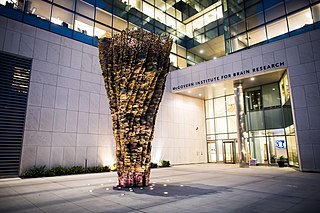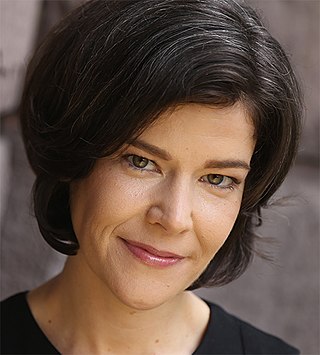
The visual cortex of the brain is the area of the cerebral cortex that processes visual information. It is located in the occipital lobe. Sensory input originating from the eyes travels through the lateral geniculate nucleus in the thalamus and then reaches the visual cortex. The area of the visual cortex that receives the sensory input from the lateral geniculate nucleus is the primary visual cortex, also known as visual area 1 (V1), Brodmann area 17, or the striate cortex. The extrastriate areas consist of visual areas 2, 3, 4, and 5.
Computational neuroscience is a branch of neuroscience which employs mathematical models, computer simulations, theoretical analysis and abstractions of the brain to understand the principles that govern the development, structure, physiology and cognitive abilities of the nervous system.

The McGovern Institute for Brain Research is a research institute within MIT. Its mission is to understand how the brain works and to discover new ways to prevent or treat brain disorders. The institute was founded in 2000 by Patrick McGovern and Lore Harp McGovern with a gift to MIT that is expected to total $350M over 20 years.
David J. Heeger is an American neuroscientist, psychologist, computer scientist, data scientist, and entrepreneur. He is a professor at New York University, Chief Scientific Officer of Statespace Labs, and Chief Scientific Officer and co-founder of Epistemic AI.

Supplementary eye field (SEF) is the name for the anatomical area of the dorsal medial frontal lobe of the primate cerebral cortex that is indirectly involved in the control of saccadic eye movements. Evidence for a supplementary eye field was first shown by Schlag, and Schlag-Rey. Current research strives to explore the SEF's contribution to visual search and its role in visual salience. The SEF constitutes together with the frontal eye fields (FEF), the intraparietal sulcus (IPS), and the superior colliculus (SC) one of the most important brain areas involved in the generation and control of eye movements, particularly in the direction contralateral to their location. Its precise function is not yet fully known. Neural recordings in the SEF show signals related to both vision and saccades somewhat like the frontal eye fields and superior colliculus, but currently most investigators think that the SEF has a special role in high level aspects of saccade control, like complex spatial transformations, learned transformations, and executive cognitive functions.

Nancy Gail Kanwisher FBA is the Walter A Rosenblith Professor of Cognitive Neuroscience in the Department of Brain and Cognitive Sciences at the Massachusetts Institute of Technology and an investigator at the McGovern Institute for Brain Research. She studies the neural and cognitive mechanisms underlying human visual perception and cognition.
Mriganka Sur is the Newton Professor of Neuroscience and Director of the Simons Center for the Social Brain at the Massachusetts Institute of Technology. He is also a Visiting Faculty Member in the Department of Computer Science and Engineering at the Indian Institute of Technology Madras and N.R. Narayana Murthy Distinguished Chair in Computational Brain Research at the Centre for Computational Brain Research, IIT Madras. He was on the Life Sciences jury for the Infosys Prize in 2010 and has been serving as Jury Chair from 2018.

Pasko Rakic is a Yugoslav-born American neuroscientist, who presently works in the Yale School of Medicine Department of Neuroscience in New Haven, Connecticut. His main research interest is in the development and evolution of the human brain. He was the founder and served as Chairman of the Department of Neurobiology at Yale, and was founder and Director of the Kavli Institute for Neuroscience. He is best known for elucidating the mechanisms involved in development and evolution of the cerebral cortex. In 2008, Rakic shared the inaugural Kavli Prize in Neuroscience. He is currently the Dorys McConell Duberg Professor of Neuroscience, leads an active research laboratory, and serves on Advisory Boards and Scientific Councils of a number of Institutions and Research Foundations.

Earl Keith Miller is a cognitive neuroscientist whose research focuses on neural mechanisms of cognitive, or executive, control. Earl K. Miller is the Picower Professor of Neuroscience with the Picower Institute for Learning and Memory and the Department of Brain and Cognitive Sciences at Massachusetts Institute of Technology. He is the Chief Scientist and co-founder of SplitSage.

Ann Martin Graybiel is an Institute Professor and a faculty member in the Department of Brain and Cognitive Sciences at the Massachusetts Institute of Technology. She is also an investigator at the McGovern Institute for Brain Research. She is an expert on the basal ganglia and the neurophysiology of habit formation, implicit learning, and her work is relevant to Parkinson's disease, Huntington's disease, obsessive–compulsive disorder, substance abuse and other disorders that affect the basal ganglia.
Biased competition theory advocates the idea that each object in the visual field competes for cortical representation and cognitive processing. This theory suggests that the process of visual processing can be biased by other mental processes such as bottom-up and top-down systems which prioritize certain features of an object or whole items for attention and further processing. Biased competition theory is, simply stated, the competition of objects for processing. This competition can be biased, often toward the object that is currently attended in the visual field, or alternatively toward the object most relevant to behavior.
Robert H. Wurtz is an American neuroscientist working as a NIH Distinguished Scientist and Chief of the Section on Visuomotor Integration at the National Eye Institute. He is a member of the US National Academy of Sciences and the American Academy of Arts and Sciences. He is recognised for developing methods for studying the visual system in 'awake-behaving' primates, a technique now widely used for the study of higher brain functions. He pioneered the study of the neuronal basis of vision and its relation with cognitive functions.

Mark Firman Bear is an American neuroscientist. He is currently the Picower Professor of Neuroscience at The Picower Institute for Learning and Memory at Massachusetts Institute of Technology. He is a former Howard Hughes Medical Institute Investigator; an Elected Fellow of the American Association for the Advancement of Science and the American Academy of Arts and Sciences; and a Member of the National Academy of Medicine.
Jessica Cardin is an American neuroscientist who is an associate professor of neuroscience at Yale University School of Medicine. Cardin's lab studies local circuits within the primary visual cortex to understand how cellular and synaptic interactions flexibly adapt to different behavioral states and contexts to give rise to visual perceptions and drive motivated behaviors. Cardin's lab applies their knowledge of adaptive cortical circuit regulation to probe how circuit dysfunction manifests in disease models.

Nicole C. Rust is an American neuroscientist, psychologist, and a Professor of Psychology at the University of Pennsylvania. She studies visual perception and visual recognition memory. She is recognized for significant advancements in experimental psychology and neuroscience.
Tirin Moore is an American neuroscientist who is a Professor of Neurobiology at Stanford University and Investigator at the Howard Hughes Medical Institute. He is known for his work on the neural mechanisms of visual perception, visually guided behavior and cognition. He was elected to the American Academy of Arts and Sciences and to the National Academy of Sciences in 2021.

Sabine Kastner is a German-born American cognitive neuroscientist. She is professor of psychology at the Princeton Neuroscience Institute at Princeton University. She also holds a visiting scientist appointment at the University of California at Berkeley.
Cyriel Marie Antoine Pennartz is a Dutch neuroscientist serving as professor and head of the Department of Cognitive and Systems Neuroscience at the University of Amsterdam, the Netherlands. He is known for his research on memory, motivation, circadian rhythms, perception and consciousness. Pennartz’ work uses a multidisciplinary combination of techniques to understand the relationships between distributed neural activity and cognition, including in vivo electrophysiology and optical imaging, animal behavior and computational modelling.
Fan Wang is a neuroscientist and professor in the MIT Department of Brain and Cognitive Sciences. She is an investigator at the McGovern Institute for Brain Research. Wang is known for her work identifying neural circuits underlying touch, pain, and anesthesia; and the development of a technique for capturing activated neuronal ensembles (CANE) to label and manipulate neurons activated by stimuli or behavioral paradigms.
Frank Tong is a cognitive neuroscientist and centennial professor of psychology at Vanderbilt University. He grew up in Toronto, Canada. Tong is recognized for his research on the neural bases of human visual perception, visual consciousness, attentional selection, face and object recognition, and visual working memory. In more recent work, he is developing deep neural network models of the human visual system.










